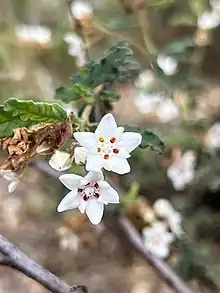| Androcalva multiloba | |
|---|---|
 | |
| Scientific classification | |
| Kingdom: | Plantae |
| Clade: | Tracheophytes |
| Clade: | Angiosperms |
| Clade: | Eudicots |
| Clade: | Rosids |
| Order: | Malvales |
| Family: | Malvaceae |
| Genus: | Androcalva |
| Species: | A. multiloba |
| Binomial name | |
| Androcalva multiloba | |
| Synonyms[1] | |
| |
Androcalva multiloba is a species of flowering plant in the family Malvaceae and is endemic to the Eyre Peninsula of South Australia. It is a dwarf shrub with densely hairy, irregularly serrated, egg-shaped leaves, and up to 5 white and red flowers arranged opposite leaf axils or on the ends of branches.
Description
Androcalva multiloba is a dwarf shrub that typically grows to 15–50 cm (5.9–19.7 in) high and 30–100 cm (12–39 in) wide, with a single stem at the base and spreading branches. The leaves are egg-shaped, 1.5–20 mm (0.059–0.787 in) long and 1.2–7.5 mm (0.047–0.295 in) wide on a petiole 0.3–5.5 mm (0.012–0.217 in) long with narrowly lance-shaped stipules 1.0–5.3 mm (0.039–0.209 in) long at the base but that fall off as the leaf matures. The leaves are arranged in small groups along the stems, the edges of the leaves with irregular serrations lobes on the edges. Both surfaces of the leaves are densely covered with star-shaped hairs. The flowers are arranged opposite the leaves or on the ends of branches in clusters of up to 5 on a peduncle 2–7 mm (0.079–0.276 in) long, each flower 9–15 mm (0.35–0.59 in) in diameter, on a pedicel 2–5 mm (0.079–0.197 in) long, with bracts 1.8–4 mm (0.071–0.157 in) long at the base. The flowers have 5 white, petal-like sepals with a green or pink base, and 5 petals with a spatula-shaped ligule that is shorter than the sepals. There are 3 staminodes between each pair of stamens. Flowering occurs from August to October, and the fruit is a softly-hairy capsule 6–12 mm (0.24–0.47 in) in diameter.[2][3]
Taxonomy
This species was first formally described in 2005 by Carolyn Wilkins and Barbara Whitlock who gave it the name Commersonia multiloba in the journal Muelleria, from specimens they collected near Cowell in 2004.[4] In 2011, Wilkins and Whitlock transferred the species to Androcalva as A. multiloba in Australian Systematic Botany.[5] The specific epithet (multiloba) refers to the many serrated lobes on the edges of the leaves.[2]
Distribution and habitat
Androcalva multiloba grows with species of Melaleuca and Acacia in two populations on the northern part of the Eyre Peninsula in south-eastern South Australia.[2][3]
References
- 1 2 "Androcalva multiloba". Australian Plant Census. Retrieved 26 April 2023.
- 1 2 3 Wilkins, Carolyn F.; Whitlock, Barbara A. (2006). "A new species of Commersonia (Malvaceae s.l.), from the Eyre Peninsula, South Australia". Muelleria. 22: 88–92. Retrieved 28 April 2023.
- 1 2 Blake, Trevor L. (2021). Lantern bushes of Australia ; Thomasias & allied genera : a field and horticultural guide. Victoria: Australian Plants Society, Keilor Plains Group. pp. 132–133. ISBN 9780646839301.
- ↑ "Commersonia multiloba". Australian Plant Name Index. Retrieved 28 April 2023.
- ↑ "Androcalva multiloba". APNI. Retrieved 28 April 2023.